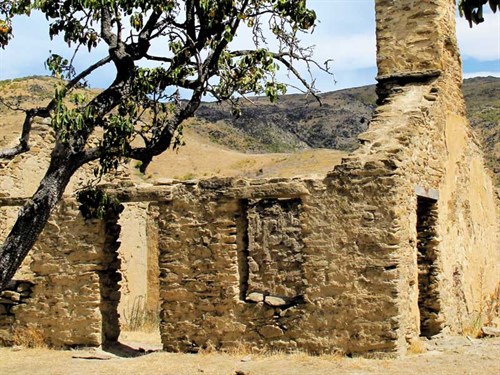
From the water, I was able to make out the rock-cave dwellings, hidden among the hard, dark folds of an unforgiving landscape. Their entrances were blocked by crude stone walls plastered with clay to conserve the heat. The doorways, through which the miners had crawled to reach the inside and some sort of refuge from the weather, were hobbit-sized. In those impossible conditions a miner might even burrow under a rock and into the ground, just to try and find a semblance of warmth when the temperatures fell below zero.
Cruising as I was in the comfort of a modern launch, it was beyond my imagination to understand the enduring hardship of the old goldminers’ lifestyles and the motivation that compelled them to place themselves on those isolated river banks in an environment as desolate and dangerous as anywhere in New Zealand.
Steve Toyer and his wife Samantha began taking people on cruises down river, where it slows to form Lake Roxburgh, leaving from Alexandra and motoring for an hour or so through the Roxburgh Gorge.
Even though it is not very long (338km), the Clutha River carries more water than any other river in New Zealand. Nor is it a tiddler in global terms, as it’s thought to be about the eighth biggest river by volume in the world. Its flow rate is around 21,700 cubic feet per second, which is hard to imagine but basically means that the river is very deep and extremely swift. For that reason, it has never been particularly navigable. But on this section cruised, created by damning the river to form Lake Roxburgh, the water flow is less fierce and allowed the boat to carry us gently into Central Otago’s rocky heart.
The stacked and buckled cliffs rise steeply from the river. They are wallpapered with rocks, some bigger than houses, others no larger than undersized rabbits. Willow trees line the water’s edge, kneeling to dip their locks into the water, which runs smooth and green, just the swirling whirlpools hinting at its underlying forces. The only vegetation these rugged cliffs support is matagouri scrub, gardens of wild thyme, hairy tussock, and the occasional green blotch of a self-seeded pine tree.
The towering sides of this canyon were shunted up by earth movement, not worn down by the river. What an earthquake that would have been, turning the earth’s crust upside down and exposing the gold created in its depths.
Pushing their victuals in wheelbarrows, the miners had trudged along a narrow path that followed the river’s course to reach their miserable homes and searched for the mineral they craved. In places, the rocky routes they took are still faintly discernible. At times the paths were so impassably jagged they had to unload their wheelbarrows, carry the items across one at a time, and then go back to carry their wheelbarrows on their backs.
Steve pointed out the long sluicing water races they built of rock high above the river, one of them 17km long. And we spotted the stand-alone building of the Leaky Lodge Pub (1863) and the stone walls of ‘Mary’s’, the old general store. Both buildings were relatively intact. Firewood was non-existent and there were glimpses of the coal-haul roads, where coal was dragged in on sledges from Coal Creek near Roxburgh. It was coal or nothing, except when a tree feller went to Wanaka, cut a few logs, threw them into the river, and floated them downstream to be grabbed by people waiting on the bank.
On the coldest shady side of the river were the huts (one still quite intact) of the Chinese miners, who, I’m sorry to say, were treated appallingly despite their superior skills in building and mining. All that was left to them was to sift through the tailings left by ‘white’ miners. They were not allowed on the ‘rich’ side of the river and were charged a ‘yellow tax’ on anything they harvested.
One story that haunted me was that of the Chinese miner Lye Bow, who is buried just outside Alexandra. He hit it rich by growing vegetables for miners and gifted a considerable amount of money to the building of the local hospital. And yet, when he was in his 80s and unwell, he was refused a hospital bed because he was Chinese. The story was painful to hear.
At Doctor’s Point we went ashore to examine a few larger huts, some of which were only finally abandoned in the 1940s. The dry-stone walls were intact and inset with windows and doors. Inside, wooden boxes had been laid on their side and set into the walls to serve as shelving. The floors were of hardened earth. Life might have been a tad more luxurious by then.
But our level of comfort aboard a modern launch was almost obscene by comparison. On the way back up the river I traced again the gruelling tracks that were the miners’ only routes to civilisation. I conjured up their arduous wheelbarrow walks and compared them to my own gliding journey. Seated as I was under a shading parasol like some river queen, I gave thanks that the scourge of gold fever would never worm its way into my bones.






